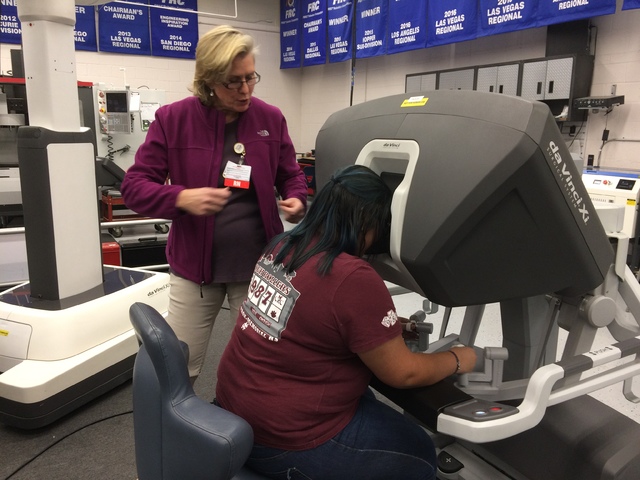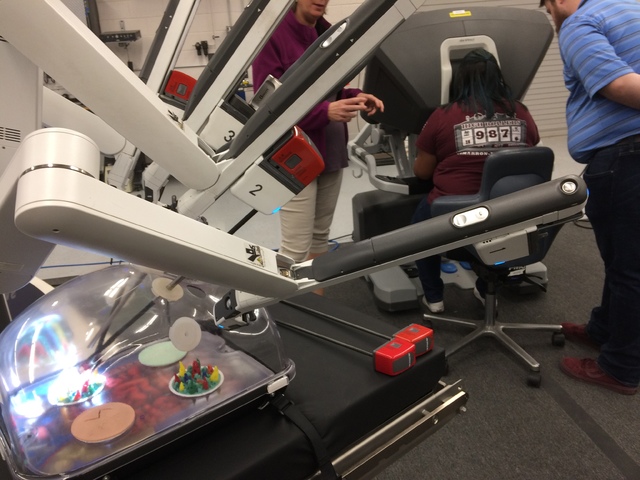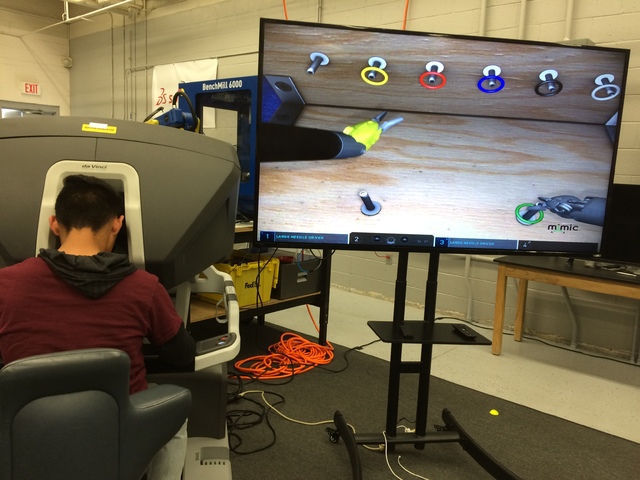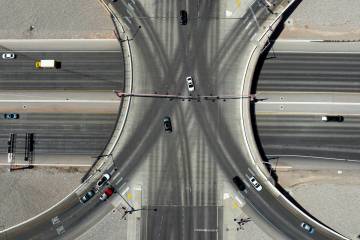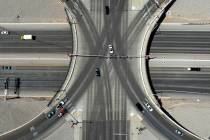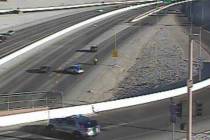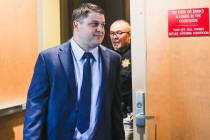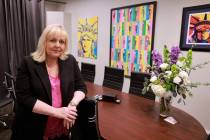Cimmaron-Memorial students operate surgical machines with 3D cameras
Perhaps playing all those video games paid off.
Students in Cimarron-Memorial High School’s robotics academy had a chance try out two machines, called the Intuitive Robotic Surgical System, just before winter break. The machines are toted around the country and are used to train doctors in virtual reality surgery.
Eleanor Markle, manager of MountainView Hospital’s robotic program, told the students how the machines worked.
“The system takes a two-dimensional picture — obviously, our insides are three-dimensional — and it gives you depth of perception,” Markle said. “So you’ll be able to see around structures and get an idea of where you are. Do you understand how that helps in surgery?”
Teacher Cody Wall was the first to try it out. He guided the pincers to the ring, picked it up and maneuvered it onto a peg. The domed display behind him, the actual peg board on which the 3D cameras were trained, mimicked his movements. The “operation” was shown on big-screen TVs around the room.
“It’s very awesome, very cool,” Wall said afterward of the virtual reality 3D system. “The biggest thing is getting used to the movement of your hands and seeing it visually. So, it’s kind of placing it (that you have to learn). If I move my arm like this, does it go as fast? But it’s pretty much the same speed. Then there’s figuring out depth.”
Ramming the lever forward, Wall said, results in hitting the board at the back of the peg board, akin to puncturing an organ. Not good.
The school made a game of seeing who could pick up and move the ring to a spot randomly selected by the machine. The roughly 45 students lined up for their turn. They practiced on the first module, then moved to the second machine, which rated how well they’d done. A score of 100 was considered surgical excellence.
Scores were written on the white board at the back of the room. Most students scored in the 70s. When a higher score went up, there were whoops, hollers and high-fives from other students.
Melanie Sanchez, 17, said it was “really hard to get the adjustment at first.
“When I first when on, I didn’t know I had to use a bit more force than I’d expected,” she said. “I thought it would automatically pick up my motion, so it took a while to see how fast it (caught up).”
She likened the experience to learning to drive a car.
Oscar Ho, 15, president of the robotics club, said having the machines there was “a really cool experience. We spend every day stressing about the importance of STEM (science, technology, engineering and math) in education, and learning robotics. But to actually see these things and see how engineering is the future, it’s exciting.”
Typical surgeries using the 3D system involve abdominal organs such as the kidneys, gall bladder and ovaries, and sometimes the lungs. Access to the throat has allowed surgeons to put their hands virtually inside someone’s body.
The system also allows for the removal of tremors. Simulation is big in health care and eventually will have other applications, such as in space technology, Markle said.
Ho, who plans to go into software programming when he graduates, said the school robotics team is visited by companies such as Intuitive Surgical, Intellitec, Full Spectrum Laser, local machine shops and Tesla about once a month.
The club, which began in 2002, has roughly 175 students at all grade levels. Hung up around the large room were more than 20 banners noting the team’s wins in competitions. Perhaps the most notable was this year’s third-place win in an international competition of more than 6,000 teams.
Jennifer Joseph, director of the school’s robotics program, said school leaders work to provide real-world experiences.
“This is amazing for our students,” she said.
To reach Summerlin Area View reporter Jan Hogan, email jhogan@viewnews.com or call 702-387-2949.



